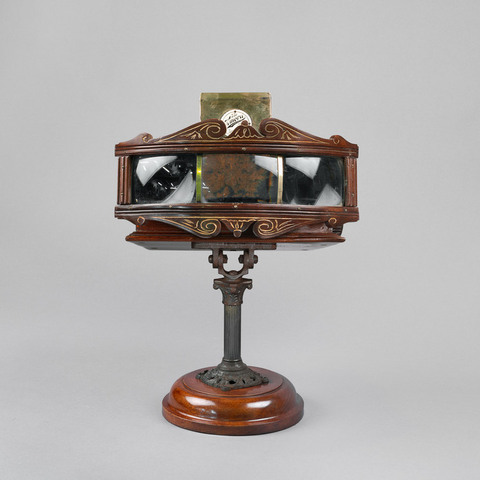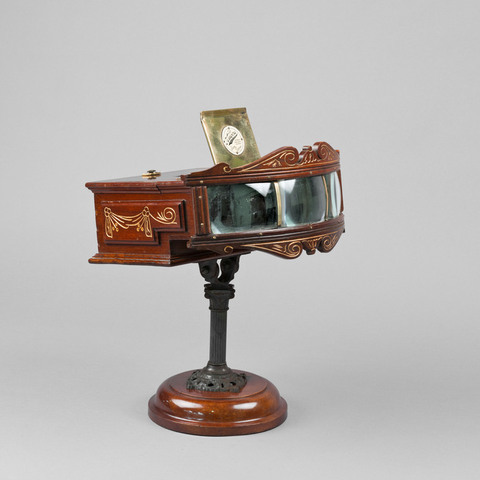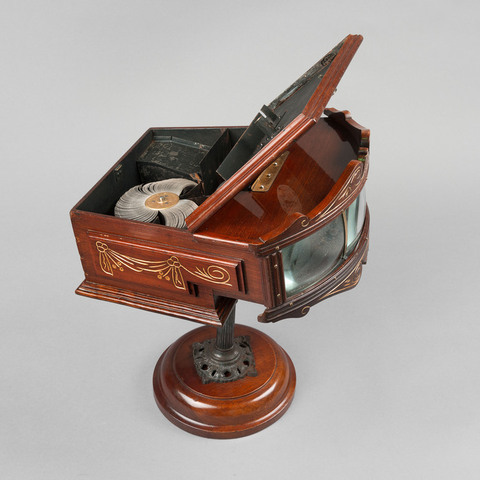Folioscope
Fiche détaillée
Type de l'appareil
visionnement par trois lentilles logées dans une visionneuse en acajou décoré, d'une roue d'images photographiques successives tirées sur papier et montées sur un axe ; moteur à ressort incorporé ; miroir orientable situé sur le dessus de la boîte ; colonne verticale du pied en bronze avec ornements ; pied en bois tourné
Auteurs
Informations non disponibles
Fabricants
British Mutoscope and Biograph Company LTD
Londres
Utilisateurs
Informations non disponibles
Distributeurs
Warwick Trading Company
Londres, 4 & 5 Warwick Court, High Holborn
Sujet du modèle
Informations non disponibles
Objectif
3 lentilles 7 x 10 cm
Taille de l'objet
Ouvert :
Informations non disponibles
Fermé :
Longueur : 34 cm
Largeur : 34.5 cm
Hauteur : 44 cm
Diamètre :
Informations non disponibles
Taille de la boîte de transport
Informations non disponibles
Remarques
Marque : "The Kinora. Patented throughout the world by Kinora Ltd., London".
Au catalogue Kinora de 1908, ce modèle est le n° 5 (vendu à cette époque £ 6,6).
"Although the British Mutoscope and Biograph Co. (a film production and exhibition company ; an offshoot of the American Mutoscope and Biograph Co., owners of Casler's related patent) had purchased the rights in the Lumière Kinora as early as June 1898, it was not until 1902 that the device appeared on the British market. One of the limitations of the original viewer was that only one person at at time could view the moving pictures. The idea of using multiple lenses, to facilitate viewing by more than one person, was patented in Britain by Elias B. Koopman, Managing Director of the British Mutoscope and Biograph Company Ltd. in 1901" (The Kinora, Motion pictures for the home 1896-1914, A history of the system, and a newly-compiled illustrated catalogue of Kinora reels, Barry Anthony, The third in a series of monographs on pre-cinema and early film, London, The Projection Box, 1996).
"Some Kinora Models exhibit the pictures to several spectators at a time. These have an internal automatic motor instead of being turned by hand. Model n° 2. Operated by clockwork, is made of mahogany with oxydized copper finish, has three lenses, and is richly embellished with gilt carving, price £ 5.0.0." (The British Journal Almanac Advertisements, Motion Photography for Amateurs, London, Bond's Ltd., s.d.).
Bibliographie
The British Journal Almanac Advertisements, Motion Photography for Amateurs, London, Bond's Ltd., s.d.
Barry Anthony, The Kinora, Motion pictures for the home 1896-1914, London, The Projection Box, 1996.
The Kinora Library, A Descriptive Lost of Moving Pictures that you may see in your own home, a reprint of the catalogue of Kinora reels published by Bond's Ltd, London, c. 1911, Hastings, East Sussex, The Projection Box, 2001.


